What'sNEW October-December 2011
...Our results imply that pathogens may be advantageous to the subsistence and prosperity of hosts through effective HGT events at a large evolutionary scale.
 Zi-Wen Li et al., "Pathogen-origin horizontally transferred genes contribute to the evolution of Lepidopteran insects" [abstract], doi:10.1186/1471-2148-11-356, v11 n356, BMC Evolutionary Biology, 12 Dec 2011. Zi-Wen Li et al., "Pathogen-origin horizontally transferred genes contribute to the evolution of Lepidopteran insects" [abstract], doi:10.1186/1471-2148-11-356, v11 n356, BMC Evolutionary Biology, 12 Dec 2011.
 Viruses and Other Gene Transfer Mechanisms is the main related local webpage — What'sNEW about HGT Viruses and Other Gene Transfer Mechanisms is the main related local webpage — What'sNEW about HGT  | |
...Different rare species living in freshwater ...all leave DNA traces in their environment which can be detected in even very small water samples from their habitat. This observation comes from a Danish research team who want a better way to monitor species diversity. The new method looks promising:

dragonfly by Lars L. Iverson |
 We find DNA from animals as different as an otter and a dragonfly. We find DNA from animals as different as an otter and a dragonfly.
 DNA detection is effective even in populations where the animals are extremely rare. DNA detection is effective even in populations where the animals are extremely rare.
 DNA traces of animals are nearly ubiquitous in the freshwater environment. DNA traces of animals are nearly ubiquitous in the freshwater environment.
 These findings may have wider implications reaching disciplines far beyond threatened species monitoring. These findings may have wider implications reaching disciplines far beyond threatened species monitoring.
The ubiquity of animal DNA in freshwater interests us for another reason. Cosmic ancestry depends heavily on gene transfer (HGT), even affecting multicelled animals. But standard darwinism holds that gene transfer among metazoans is rare and inconsequential. Now we learn that all this DNA is freely available in the water. Here we see circumstantial evidence in favor of robust gene transfer, even among species like otters and dragonflies.
 Philip Francis Thomsen et al., "Monitoring endangered freshwater biodiversity using environmental DNA" [abstract], doi:10.1111/j.1365-294X.2011.05418.x, Molecular Ecology, first published online 13 Dec 2011. Philip Francis Thomsen et al., "Monitoring endangered freshwater biodiversity using environmental DNA" [abstract], doi:10.1111/j.1365-294X.2011.05418.x, Molecular Ecology, first published online 13 Dec 2011.
 Andrew M. Sugden, "DNA Leaves a Trace" [html], p14 v335, Science, 6 Jan 2012. Andrew M. Sugden, "DNA Leaves a Trace" [html], p14 v335, Science, 6 Jan 2012.
 A lake fauna in a shot-glass, University of Copenhagen (also EurekAlert!), 11 Dec 2011. A lake fauna in a shot-glass, University of Copenhagen (also EurekAlert!), 11 Dec 2011.
 Viruses and Other Gene Transfer Mechanisms is the main related local webpage — What'sNEW about HGT Viruses and Other Gene Transfer Mechanisms is the main related local webpage — What'sNEW about HGT  | |
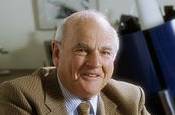 The Baruch Blumberg Chair in Astrobiology has been established at the Library of Congress. "Barry" was the founding leader of NASA's Astrobiology Program.
The Baruch Blumberg Chair in Astrobiology has been established at the Library of Congress. "Barry" was the founding leader of NASA's Astrobiology Program.
 NASA and Library of Congress Establish Chair in Astrobiology, The Library of Congress, 30 Nov - 1 Dec 2011. NASA and Library of Congress Establish Chair in Astrobiology, The Library of Congress, 30 Nov - 1 Dec 2011.
 The NASA Astrobiology Institute Virus Focus Group was one of Barry's projects, What'sNEW, 19 Oct 2003. The NASA Astrobiology Institute Virus Focus Group was one of Barry's projects, What'sNEW, 19 Oct 2003.
 Thanks for an alert, Elizabeth Gettins. Thanks for an alert, Elizabeth Gettins.
The data from every direction support the interstellar life and panspermia hypothesis. It is admitted by everyone that there is no easy way to explain all the data without an extremely complex set of hypotheses, and even then the fits are not as good as with biology. The detritus of life is everywhere. People are still afraid to admit this, but it is bound to come.
Chandra Wickramasinghe of the Buckingham Centre for Astrobiology makes these comments in email after an international conference on interstellar dust in Pune India. His own presentation there states the case convincingly. We hope it will be noticed. Distinguished attendees included (below, left to right) Sun Kwok the University of Hong Kong; Thomas Henning of the Max Planck Institut für Astronomie, Heidelberg; and Chandra. The conference website has links to many of the presentations.
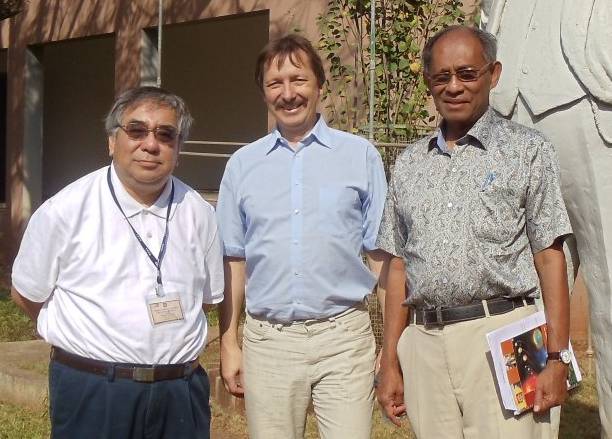
 International Conference on Interstellar Dust, Molecules and Chemistry, Pune, India, 22-25 Nov 2011. International Conference on Interstellar Dust, Molecules and Chemistry, Pune, India, 22-25 Nov 2011.
 Chandra Wickramasinghe, "Interstellar Extinction - A revisit" [local 77-pg, 7Mb PDF], 22 Nov 2011. Chandra Wickramasinghe, "Interstellar Extinction - A revisit" [local 77-pg, 7Mb PDF], 22 Nov 2011.
 Hoyle and Wickramasinghe's Analysis of Interstellar Dust is a related local webpage. Hoyle and Wickramasinghe's Analysis of Interstellar Dust is a related local webpage.
 Cross-Linked Hetero Aromatic Polymers in Interstellar Dust is a related reprint posted 1 May 2000. Cross-Linked Hetero Aromatic Polymers in Interstellar Dust is a related reprint posted 1 May 2000.
 The Physical and Chemical Properties of Interstellar Dust and Dust in Comets: Possible Seeds for Life on Earth by Franz R. Krueger and Jochen Kissel is a related reprint first published in Sterne und Weltraum, May 2000. The Physical and Chemical Properties of Interstellar Dust and Dust in Comets: Possible Seeds for Life on Earth by Franz R. Krueger and Jochen Kissel is a related reprint first published in Sterne und Weltraum, May 2000.
 Professor Sun Kwok is quoted in What'sNEW, 27 Oct 2011. Professor Sun Kwok is quoted in What'sNEW, 27 Oct 2011.
 Lynn Margulis died on November 22nd. A professor at the University of Massachusetts Amherst, she was best known for her work on endosymbiosis. She also was an early supporter of Gaia.
Lynn Margulis died on November 22nd. A professor at the University of Massachusetts Amherst, she was best known for her work on endosymbiosis. She also was an early supporter of Gaia.
 Lynn Margulis 1938 - 2011, Nature.com, 23 Nov 2011. Lynn Margulis 1938 - 2011, Nature.com, 23 Nov 2011.
 Lynn Margulis, Evolution Theorist, Dies at 73 by Bruce Weber, The New York Times, 24 Nov 2011. Lynn Margulis, Evolution Theorist, Dies at 73 by Bruce Weber, The New York Times, 24 Nov 2011.
 Lynn Margulis, leading evolutionary biologist, dies at 73 by Martin Weil, The Washington Post, 26 Nov 2011. Lynn Margulis, leading evolutionary biologist, dies at 73 by Martin Weil, The Washington Post, 26 Nov 2011.
 "Lynn Margulis" [html], The Telegraph, 13 Dec 2011. "Lynn Margulis" [html], The Telegraph, 13 Dec 2011.
 James A. Lake, "Lynn Margulis (1938-2011)" [html], doi:10.1038/480458a, p458 v480, Nature, 22/29 Dec 2011. James A. Lake, "Lynn Margulis (1938-2011)" [html], doi:10.1038/480458a, p458 v480, Nature, 22/29 Dec 2011.
 Moselio Schaechter, "Lynn Margulis (1938-2011)" [summary], doi:10.1126/science.1218027, p302 v335, Science, 20 Jan 2012. Moselio Schaechter, "Lynn Margulis (1938-2011)" [summary], doi:10.1126/science.1218027, p302 v335, Science, 20 Jan 2012.
 Why Sexual Reproduction? and Why Sexual Reproduction? and
 Gaia are about two of Margulis's major scientific interests. Gaia are about two of Margulis's major scientific interests.
 18 Apr 2011 an interview with Lynn Margulis, Discover. 18 Apr 2011 an interview with Lynn Margulis, Discover.
 Medvedev: Punishment awaits those behind Russian Mars failure, Nature.com, 28 Nov 2011. Medvedev: Punishment awaits those behind Russian Mars failure, Nature.com, 28 Nov 2011.
Contact with Phobos-Grunt  ESA tracking station establishes contact..., ESA, 23 Nov 2011. ESA tracking station establishes contact..., ESA, 23 Nov 2011.
 ESA Picks Up Signal From Defunct Mars Probe by Daniel Clery, ScienceInsider, 23 Nov 2011. ESA Picks Up Signal From Defunct Mars Probe by Daniel Clery, ScienceInsider, 23 Nov 2011.
 Phobos is in trouble is the beginning of the related What'sNEW article, 11-16 Nov 2011. Phobos is in trouble is the beginning of the related What'sNEW article, 11-16 Nov 2011.
Where do new genes come from? Geneticists in China and Canada offer an answer in a recent report, "De Novo Origin of Human Protein-Coding Genes". Although standard theory expects de novo genes to be "very rare," 60 of them in humans were apparently activated from formerly silent DNA after humans and chimps diverged.
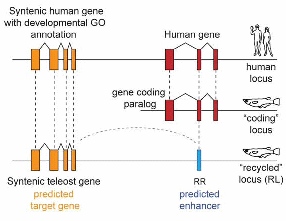 A similar report describes "De Novo Genesis of Enhancers in Vertebrates". Two biologists at the University of Heidelberg write, "...We show that enhancers don't have to be derived from pre-existing ones but can also appear de novo in regions of the genome that were previously not regulating gene expression. ...We predict that such a process is frequent in vertebrate genomes, making de novo generation of enhancers an important mechanism for creating variation in gene expression." They described the genes as "recycled".
A similar report describes "De Novo Genesis of Enhancers in Vertebrates". Two biologists at the University of Heidelberg write, "...We show that enhancers don't have to be derived from pre-existing ones but can also appear de novo in regions of the genome that were previously not regulating gene expression. ...We predict that such a process is frequent in vertebrate genomes, making de novo generation of enhancers an important mechanism for creating variation in gene expression." They described the genes as "recycled".
In standard theory, this phenomenon should be rare, because, if the genes were already programmed before their programs were deployed, there would have been no opportunity for standard darwinian trial-and-error to do the programming. (The German team supposes that the genes were originally functional but went silent for a long time.)
|
I once thought that the term de novo pertained to new genes composed by standard darwinian trial-and-error, but I was mistaken. The term actually pertains to the activation of fully or nearly functional genes found within previously silent DNA — DNA formerly labelled "junk".
|
Evidence shows that many genes, like the de novo ones discussed here, precede their own expression. We think all genes do. And we note that software management systems, using tools like gene conversion, can keep silent genes uncorrupted over many generations. Thus, de novo genes confirm a fundamental prediction of cosmic ancestry.
 Dong-Dong Wu et al., "De Novo Origin of Human Protein-Coding Genes" [html], doi:10.1371/journal.pgen.1002379, v7 n11 e1002379, PLoS Genetics, online 10 Nov 2011. Dong-Dong Wu et al., "De Novo Origin of Human Protein-Coding Genes" [html], doi:10.1371/journal.pgen.1002379, v7 n11 e1002379, PLoS Genetics, online 10 Nov 2011.
 Michael P. Eichenlaub and Laurence Ettwiller, "De Novo Genesis of Enhancers in Vertebrates" [html], doi:10.1371/journal.pbio.1001188, v9 n11 e1001188, PLoS Biology, online 1 Nov 2011. Michael P. Eichenlaub and Laurence Ettwiller, "De Novo Genesis of Enhancers in Vertebrates" [html], doi:10.1371/journal.pbio.1001188, v9 n11 e1001188, PLoS Biology, online 1 Nov 2011.
 Human Genome Search... is a related local webpage. Human Genome Search... is a related local webpage.
 Metazoan Genes Older Than Metazoa? is a related local webpage. Metazoan Genes Older Than Metazoa? is a related local webpage.
 A Wordcount for Comparison discusses de novo and other paths of gene "origination." A Wordcount for Comparison discusses de novo and other paths of gene "origination."
 Conserved Non-Genic Sequences is a related local webpage. Conserved Non-Genic Sequences is a related local webpage.
 Three New Human Genes is about de novo genes in humans and elsewhere. Three New Human Genes is about de novo genes in humans and elsewhere.
 Viruses... has very many examples of acquired genes — What'sNEW about HGT Viruses... has very many examples of acquired genes — What'sNEW about HGT  | |
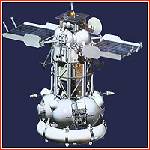
 December deadline for stranded Russian Mars probe by Stephen Clark, Spaceflight Now, 14 Nov 2011. December deadline for stranded Russian Mars probe by Stephen Clark, Spaceflight Now, 14 Nov 2011.
 Thanks for a facebook alert, David Darling. Thanks for a facebook alert, David Darling.
 More about Phobos, What'sNEW, 25-28 Nov 2011.
All attempts to establish contact with the Phobos-Grunt spacecraft made by Russian and European ground controllers during the night from November 11 to November 12 proved fruitless once again. More about Phobos, What'sNEW, 25-28 Nov 2011.
All attempts to establish contact with the Phobos-Grunt spacecraft made by Russian and European ground controllers during the night from November 11 to November 12 proved fruitless once again.
 Phobos-Grunt flight timeline on RussianSpaceWeb.com. Phobos-Grunt flight timeline on RussianSpaceWeb.com.
Phobos is in trouble. This Russian mission with 20 instruments aboard was aimed at the tiny Martian moon Phobos. A primary objective was to collect a sample from the surface and return it to Earth for study. Now the spacecraft may not get there. The rocket engine that would lift it from Earth orbit did not fire. It may be fixable, but the symptoms are discouraging.
 ...Russian Phobos Probe Stranded in Orbit by Daniel Clery, ScienceInsider, 9 Nov 2011. ...Russian Phobos Probe Stranded in Orbit by Daniel Clery, ScienceInsider, 9 Nov 2011.
 Phobos-Grunt homepage on RussianSpaceWeb.com. Phobos-Grunt homepage on RussianSpaceWeb.com.
 Phobus-Grunt..., an earlier What'sNEW article with more about the mission, 12 Jul 2009. Phobus-Grunt..., an earlier What'sNEW article with more about the mission, 12 Jul 2009.
Almost every month now we are seeing genes that were supposed to be exclusive to metazoans that are already present in their single-cell relatives, says evolutionary biologist Iñaki Ruiz-Trillo of the University of Barcelona in a review in The Scientist. Advances in genomics research... are revealing that more and more of the genes associated with complex processes also exist in simpler animals and even in their unicellular cousins. This puzzle for mainstream theory is steadily growing. Additional excerpts from the review —
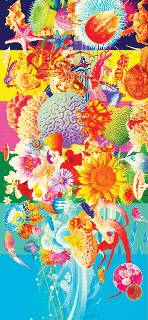
adapted from Sean McCabe |
- Sponges are commonly considered the most basal of all the metazoan (animal) lineages, yet a recently published sponge genome revealed genes known to be involved in the development of a neuromuscular system, which sponges lack.
- Choanoflagellates, unicellular organisms ...also share a number of genes once thought to be unique to multicellular animals... tyrosine kinases (TK), for example... and many other components of the TK signaling pathway as well. "So this gene family that was thought to be essentially a trigger that unleashed animal origins, we can now say with great confidence evolved long before the origin of animals," says evolutionary biologist Nicole King of the University of California, Berkeley.
- ...Recently, a widespread search for genes associated with integrin-mediated adhesion and signaling pathways revealed that the integrin adhesion complex originated much earlier than even the choanoflagellates, dating back to the common ancestor of animals and fungi. "It's pretty surprising to find these adhesion genes in far-flung species," says evolutionary biologist Mansi Srivastava of the Whitehead Institute for Biomedical Research in Massachusetts. "We would have thought that integrin signaling has to do with cells sticking together, but it goes much further back in time than our most recent unicellular cousins."
Two species have become models for the evolution of multicellularity: the single-celled Chlamydomonas reinhardtii and the 2,000-or-so–celled Volvox carteri. The latter contains a gene that is essential for its asymmetric cell division, but an ortholog in Chlamydomonas, when inserted into the Volvox genome, "is perfectly capable of carrying out the same function." Likewise, a gene that is essential for giving adult Volvox its spherical shape has an ortholog in Chlamydomonas that can provide the same function.
Why Chlamydomonas has these genes is a complete mystery for standard theory. Apparently they, and many other genes, existed long before the features they encode. If so, there was no opportunity for trial-and-error to compose them. In response, mainstream theorists suggest that the puzzling genes originally served other purposes, but, luckily, also happen to encode new metazoan functions. Is this credible?
We think genes come first, before the earthly evolution of the features they encode. Advanced genes in simple organisms confirm a basic prediction of cosmic ancestry.
 From Simple To Complex by Jef Akst, The Scientist, 1 Jan 2011. From Simple To Complex by Jef Akst, The Scientist, 1 Jan 2011.
 Metazoan Genes Older Than Metazoa? is a local webpage with related text and links. Metazoan Genes Older Than Metazoa? is a local webpage with related text and links.
 Genes Older Than Earth? is a possibly related local webpage. Genes Older Than Earth? is a possibly related local webpage.
 Thanks for the alert, Stan Franklin. Thanks for the alert, Stan Franklin.
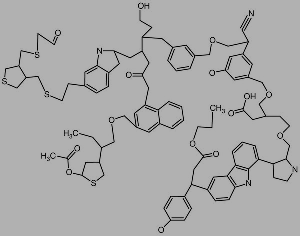 Theoretically, this is impossible, but observationally we can see it happening, says Professor Sun Kwok of The University of Hong Kong. Analyzing spectra from the Infrared Space Observatory archive, he and Dr. Yong Zhang conclude that organic compounds seen throughout the Universe are quite complex, resembling those in coal and petroleum. On Earth, these compounds are remnants of ancient life. ...This type of organic matter was thought to arise only from living organisms.
Theoretically, this is impossible, but observationally we can see it happening, says Professor Sun Kwok of The University of Hong Kong. Analyzing spectra from the Infrared Space Observatory archive, he and Dr. Yong Zhang conclude that organic compounds seen throughout the Universe are quite complex, resembling those in coal and petroleum. On Earth, these compounds are remnants of ancient life. ...This type of organic matter was thought to arise only from living organisms.
Interestingly, the proposed complex organics are very similar to those found in carbonaceous meteorites like Murchison. The presence of insoluble organic matter in meteorites is evidence that complex organic solids form in nature with no difficulty. The fact that insoluble organic matter and circumstellar dust have similar chemical structures offers the possibility that Solar System organics may have a stellar connection.
The reaction of mainstream science is to propose the existence of a previously unsuspected chemistry that can produce complex organics in space. The team's discovery suggests that complex organic compounds can be synthesized in space even when no life forms are present. But complex organics definitely can been made by life. Not just theoretically. This is possible!
 Sun Kwok and Yong Zhang, "Mixed aromatic–aliphatic organic nanoparticles as carriers of unidentified infrared emission features" [abstract], doi:10.1038/nature10542, Nature, online 26 Oct 2011. Sun Kwok and Yong Zhang, "Mixed aromatic–aliphatic organic nanoparticles as carriers of unidentified infrared emission features" [abstract], doi:10.1038/nature10542, Nature, online 26 Oct 2011.
 Mysterious Absorption Lines Could Illuminate 90-year Puzzle by Susan Gawlowicz, Rochester Institute of Technology, 2 Nov 2011. Mysterious Absorption Lines Could Illuminate 90-year Puzzle by Susan Gawlowicz, Rochester Institute of Technology, 2 Nov 2011.
 HKU Astronomers Discover Complex Organic Matter in the Universe, Physorg.com, 26 Oct 2011. HKU Astronomers Discover Complex Organic Matter in the Universe, Physorg.com, 26 Oct 2011.
 Cosmic dust contains organic matter from stars, study finds by Denise Chow, MSNBC.com, 26 Oct 2011. Cosmic dust contains organic matter from stars, study finds by Denise Chow, MSNBC.com, 26 Oct 2011.
 Hoyle and Wickramasinghe's Analysis of Interstellar Dust is a related local webpage. Hoyle and Wickramasinghe's Analysis of Interstellar Dust is a related local webpage.
 The Physical and Chemical Properties of Interstellar Dust and Dust in Comets: Possible Seeds for Life on Earth is a related local webpage. The Physical and Chemical Properties of Interstellar Dust and Dust in Comets: Possible Seeds for Life on Earth is a related local webpage.
 Comets: The Delivery System is a related local webpage. Comets: The Delivery System is a related local webpage.
 Thanks for the alerts, Stan Franklin, Bob Sweeney, Ken Jopp, Martin Langford and Jeff Krolick. Thanks for the alerts, Stan Franklin, Bob Sweeney, Ken Jopp, Martin Langford and Jeff Krolick.
New genes are preferentially expressed in the early development of the human brain, according to a team at The University of Chicago. To ascertain this they compared expression levels for young and old genes in developing brain tissue in humans versus mice and other species. The researchers surmise that those new genes have important functions in brain development. If so, they could account for "the genetic changes that underlie the evolution of the human brain." This is noteworthy.
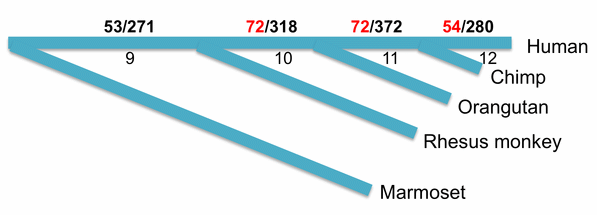
The number of genes up-regulated in the prefrontal cortex (PFC) and the total number of new genes after primate split. For example, there are 280 human-specific [young] genes, 54 of which are up-regulated in PFC. In total, there are 72+72+54=198 genes up-regulated in PFC (marked in red), which originated along hominoid branches. |
The study also showed that the new genes evolved significantly faster than the average rate, supporting the case that "new genes may in general be subject to positive selection." And earlier new genes probably had similar significance in brain development for chimps, orangutans and Rhesus monkeys, they conclude (see figure).
The authors report that the new brain-development genes must have "originated" in each lineage after it diverged from its evolutionary predecessors. They explain, "...We dated their originations by inferring the presence and absence of orthologs along the vertebrate phylogenetic tree...." This method reveals that their language is misleading, because nothing in their data shows that the genes ever "originated" at all, only that they were absent until they were present. Perhaps instead they arrived. In any case, we wish that precision in language were more strictly observed. Science requires it.
 Zhang YE, Landback P, Vibranovski MD, Long M, "Accelerated Recruitment of New Brain Development Genes into the Human Genome" [html], doi:10.1371/journal.pbio.1001179, PLoS Biol 9(10): e1001179, online 18 Oct 2011. Zhang YE, Landback P, Vibranovski MD, Long M, "Accelerated Recruitment of New Brain Development Genes into the Human Genome" [html], doi:10.1371/journal.pbio.1001179, PLoS Biol 9(10): e1001179, online 18 Oct 2011.
 New genetic programs in Darwinism and strong panspermia — we predict that predecessor genes will be either "nearly identical" (today's genes are obviously old), or "nothing similar" (today's genes appear to be young, or new), as in the above study. New genetic programs in Darwinism and strong panspermia — we predict that predecessor genes will be either "nearly identical" (today's genes are obviously old), or "nothing similar" (today's genes appear to be young, or new), as in the above study.
 Human Genome Search is a related local webpage. Human Genome Search is a related local webpage.
A water ice reservoir equivalent to several thousand Earth oceans in the planet-forming disk around a young star is indicated by data from the Herschel Space Observatory. Plentiful water in such reservoirs would supply ice for comet formation. Comets, in turn, would bring water to planets and enable life to flourish there, as is already suspected for our own planet. This tells us that the key materials that life needs are present in a system before planets are born, says Ted Bergin, University of Michigan astronomy professor and co-author of the new report.
 Michiel R. Hogerheijde et al., "Detection of the Water Reservoir in a Forming Planetary System" [abstract], doi:10.1126/science.1208931, p338-340 v334, Science, 21 Oct 2011. Michiel R. Hogerheijde et al., "Detection of the Water Reservoir in a Forming Planetary System" [abstract], doi:10.1126/science.1208931, p338-340 v334, Science, 21 Oct 2011.
 Rachel Akeson, "Watery Disks" [summary], doi:10.1126/science.1213752, p316-317 v334, Science, 21 Oct 2011. Rachel Akeson, "Watery Disks" [summary], doi:10.1126/science.1213752, p316-317 v334, Science, 21 Oct 2011.
 "Ice in the outer reaches" [html], doi:10.1038/478430e, p430-431 v478, Nature, 27 Oct 2011. "Ice in the outer reaches" [html], doi:10.1038/478430e, p430-431 v478, Nature, 27 Oct 2011.
 Nearby planet-forming disk holds water for thousands of oceans, The University of Michigan News Service (also Newswise), 20 Oct 2011. Nearby planet-forming disk holds water for thousands of oceans, The University of Michigan News Service (also Newswise), 20 Oct 2011.
 New Proof That Comets Watered the Earth by Jeffrey Kluger, Time.com, 11 Oct 2011. New Proof That Comets Watered the Earth by Jeffrey Kluger, Time.com, 11 Oct 2011.
 Comets: The Delivery System is a related local webpage. Comets: The Delivery System is a related local webpage.
 Thanks for the Time.com link, Bill and Ann Tucker. Thanks for the Time.com link, Bill and Ann Tucker.
Consensus is for textbooks; real science depends for its progress on continual challenges to the current state of always-imperfect knowledge — Daniel Sarewitz, Director, Consortium for Science, Policy & Outcomes, Arizona State University
 The voice of science: let's agree to disagree, doi:10.1038/478007a, NatureNews, online 5 Oct 2011. The voice of science: let's agree to disagree, doi:10.1038/478007a, NatureNews, online 5 Oct 2011.
 Astrobiology comes to Buckingham, the Buckingham Centre for Astrobiology, 18 Oct 2011. Astrobiology comes to Buckingham, the Buckingham Centre for Astrobiology, 18 Oct 2011.
Panspermia might reconcile creationism and neo-Darwinism according to a paper available online today. The authors are Chandra Wickramasinghe and me.
 Brig Klyce and Chandra Wickramasinghe, "Creationism, Neo-Darwinism and Panspermia" [local pdf], Journal of Cosmology, online 11 Oct 2011. Brig Klyce and Chandra Wickramasinghe, "Creationism, Neo-Darwinism and Panspermia" [local pdf], Journal of Cosmology, online 11 Oct 2011.
 Comparing Darwinism, Creationism/ID and Cosmic Ancestry is a related local webpage. Comparing Darwinism, Creationism/ID and Cosmic Ancestry is a related local webpage.
 Evolution versus Creationism is a related local webpage. Evolution versus Creationism is a related local webpage.
 Thanks for a heads up, Ronnie McGhee. Thanks for a heads up, Ronnie McGhee.
Neopanspermia and pathospermia are new terms introduced in a paper available online today. And Hoyle and Wickramasinghe's modern version of panspermia is known by the descriptive term, cometary panspemia.
 Milton Wainwright, Sulamain Aharbi and Khalid Alabri, "Panspermia–Nature's Exercise in Microbial Cultivation on a Vast Scale" [6-page pdf], Journal of Cosmology, online 9 Oct 2011. Milton Wainwright, Sulamain Aharbi and Khalid Alabri, "Panspermia–Nature's Exercise in Microbial Cultivation on a Vast Scale" [6-page pdf], Journal of Cosmology, online 9 Oct 2011.
 Introduction: More Than Panspermia is a related local webpage. Introduction: More Than Panspermia is a related local webpage.
 Panspermia Asks New Questions lists other kinds of panspermia. Panspermia Asks New Questions lists other kinds of panspermia.
The protein was there to begin with.... — Gustavo Caetano-Anollés, Institute for Genomic Biology at University of Illinois
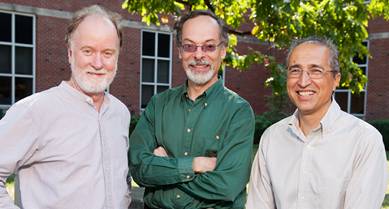
University of Illinois professors: of entomology, James Whitfield, and of crop sciences, Gustavo Caetano-Anollés and Manfredo Seufferheld. Photo by L. Brian Stauffer |
Three biologists at the University of Illinois find evidence that a protein in certain organelles is more ancient than the origin of cells on Earth. "The study lends support to a hypothesis that LUCA [the Last Universal Common Ancestor of cells] may have been more complex even than the simplest organisms alive today [cells]."
"Our findings suggest that the V-H+PPases, which are universally distributed and tightly associated with the acidocalcisome, originated prior to the divergence of the three superkingdoms." (Actually, the findings say nothing about the proteins' origin, but indicate only their prior existence. We wish this distinction were not overlooked. Science requires precision.)
If a protein with a domain of 57 amino acids that is highly conserved across life's kingdoms existed before there were cells, it presents a big problem for darwinism. Other lines of evidence also point to genetic programs that existed before they were expressed on Earth — again problematic. In fact, many phylogenomic analyses like this one are finding "early complexity" everywhere. But darwinian origin-of-life theory requires simplicity in the deepest past — increasing complexity should come only later. Neo-darwinism requires genetic programs that originate by trial-and-error during many generations of cellular reproduction. How is early complexity possible without cells?
In cosmic ancestry, how genetic programs originate is an unwarranted question. It seeks to explain phenomena that are not observed.
 Manfredo J Seufferheld et al., "Evolution of vacuolar proton pyrophosphatase domains and volutin granules: clues into the early evolutionary origin of the acidocalcisome" [abstract], doi:10.1186/1745-6150-6-50, v6 n50, Biology Direct, 5 Oct 2011. Manfredo J Seufferheld et al., "Evolution of vacuolar proton pyrophosphatase domains and volutin granules: clues into the early evolutionary origin of the acidocalcisome" [abstract], doi:10.1186/1745-6150-6-50, v6 n50, Biology Direct, 5 Oct 2011.
 Last Universal Common Ancestor had a complex cellular structure by Diana Yates, The University of Illinois, 5 Oct 2011. Last Universal Common Ancestor had a complex cellular structure by Diana Yates, The University of Illinois, 5 Oct 2011.
 Last universal common ancestor more complex than previously thought, Physorg.com, 5 Oct 2011. Last universal common ancestor more complex than previously thought, Physorg.com, 5 Oct 2011.
 Metazoan Genes Older Than Metazoa? is a local webpage with related text and links. Metazoan Genes Older Than Metazoa? is a local webpage with related text and links.
 Genes Older Than Earth? is a possibly related local webpage. Genes Older Than Earth? is a possibly related local webpage.
 Thanks for the alert, Stan Franklin. Thanks for the alert, Stan Franklin.
Snow has been falling on Enceladus for up to 100 million years, according to a report presented yesterday at a joint meeting of the European Planetary Science Congress and the American Astronomical Society's Division for Planetary Sciences in Nantes, France.
High resolution images from the Cassini spacecraft show landscapes resembling thick blankets of snow draped over surface features. Meanwhile, an anomalous bluish color on Enceladus maps closely with the predicted pattern (shown) of surface deposition of particles discharged in plumes observed near the south pole there. The bluish color is consistent with water ice — snow.
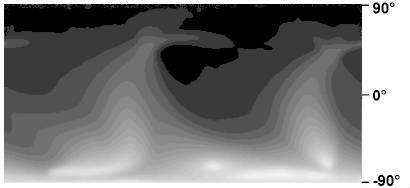
While most of the discharge escapes, eventually to Saturn's outermost ring, an estimated micrometer per year falls back onto Enceladus's surface. To acculumate to its estimated thickness of 100 meters, it must have been falling for about 100 million years.
The likeliest source for Enceladus's plumes is an ocean under the surface, heated above the melting point. A liquid ocean that has persisted for that long may well contain life. Other evidence also points to life there.
 P. Schenk, J. Schmidt and O. White, "The Snows of Enceladus" [abstract], EPSC Abstracts, v6, EPSC-DPS2011-1358, online Oct 2011. P. Schenk, J. Schmidt and O. White, "The Snows of Enceladus" [abstract], EPSC Abstracts, v6, EPSC-DPS2011-1358, online Oct 2011.
 Saturn's moon has never-ending winter, doi:10.1038/news.2011.569, by Ron Cowen, NatureNews, online 3 Oct 2011. Saturn's moon has never-ending winter, doi:10.1038/news.2011.569, by Ron Cowen, NatureNews, online 3 Oct 2011.
 Aspen in Space, by Govert Schilling, ScienceNow, 3 Oct 2011. Aspen in Space, by Govert Schilling, ScienceNow, 3 Oct 2011.
 Life on Europa, Other Moons, Other Planets? is a local webpage with links to more about possible life there. Search for "Enceladus". Life on Europa, Other Moons, Other Planets? is a local webpage with links to more about possible life there. Search for "Enceladus".
|


 Lynn Margulis died on November 22nd. A professor at the University of Massachusetts Amherst, she was best known for her work on endosymbiosis. She also was an early supporter of Gaia.
Lynn Margulis died on November 22nd. A professor at the University of Massachusetts Amherst, she was best known for her work on endosymbiosis. She also was an early supporter of Gaia. 
 Theoretically, this is impossible, but observationally we can see it happening, says Professor Sun Kwok of The University of Hong Kong. Analyzing spectra from the Infrared Space Observatory archive, he and Dr. Yong Zhang conclude that organic compounds seen throughout the Universe are quite complex, resembling those in coal and petroleum. On Earth, these compounds are remnants of ancient life. ...This type of organic matter was thought to arise only from living organisms.
Theoretically, this is impossible, but observationally we can see it happening, says Professor Sun Kwok of The University of Hong Kong. Analyzing spectra from the Infrared Space Observatory archive, he and Dr. Yong Zhang conclude that organic compounds seen throughout the Universe are quite complex, resembling those in coal and petroleum. On Earth, these compounds are remnants of ancient life. ...This type of organic matter was thought to arise only from living organisms.

 A similar report describes "De Novo Genesis of Enhancers in Vertebrates". Two biologists at the University of Heidelberg write, "...We show that enhancers don't have to be derived from pre-existing ones but can also appear de novo in regions of the genome that were previously not regulating gene expression. ...We predict that such a process is frequent in vertebrate genomes, making de novo generation of enhancers an important mechanism for creating variation in gene expression." They described the genes as "recycled".
A similar report describes "De Novo Genesis of Enhancers in Vertebrates". Two biologists at the University of Heidelberg write, "...We show that enhancers don't have to be derived from pre-existing ones but can also appear de novo in regions of the genome that were previously not regulating gene expression. ...We predict that such a process is frequent in vertebrate genomes, making de novo generation of enhancers an important mechanism for creating variation in gene expression." They described the genes as "recycled".



